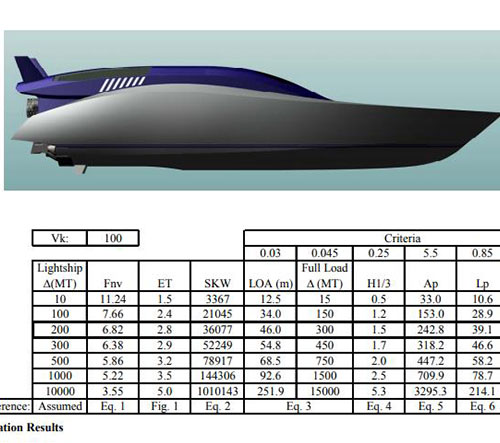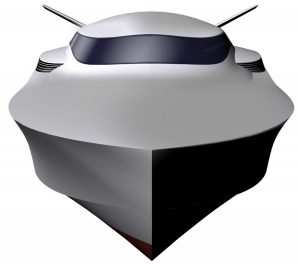DLBA UNIVERSITY
Technical Feasibility of the 100 Knot Yacht
MAY 24, 2019
By Dean M. Schleicher, P.E.
Donald L. Blount and Associates, Inc. has design cognizance over four of the world’s fastest fifteen megayachts. Included in the list of the fastest yachts are the gas turbine Motor Yacht DESTRIERO and the gas turbine Motor Yacht FORTUNA. GTMY DESTRIERO, length overall of 67.7m (222 feet), holds the record for the fastest Eastbound trans-Atlantic crossing at 53.09 knots. GTMY FORTUNA, length overall of 41.5m (136 feet), has been featured in The Superyachts, Volume 14 and achieved a 68 knot top speed during trials. Through these and a number of other projects, the state-of-the-art for gas turbine / waterjet propelled large yachts has been defined.

This paper explores the feasibility of a 100 knot yacht. The analysis is based on data available within the public domain and examines the relationship between weight, power and speed for a variety of hull forms. Assuming a desired speed of 100 knots, the relationship between size and power required is determined from state-of-the-art curves. Various displacements, representing yachts of different sizes, are assumed and the power required to drive each size yacht is determined. From a length-displacement regression, the length of each yacht is determined. The selection of a hard-chine planing mono-hull is explained.
In addition to the 100 knot requirement, the vessel has the requirement to be a true yacht with creature comforts and accouterments befitting a yacht. Key to the performance of the vessel is its ability to handle seas. Recommendations for maximum sea state operation are provided. The number of propulsors are determined and the philosophy behind the selection of the gas turbine / waterjet drive train is discussed. Recommendations for power plant sizing are provided and initial range estimates are determined. Finally, some ofthe technical difficulties to be overcome are addressed.
In case you would like to receive the full paper, or discuss about this subject, please contact Jeffrey Bowles

References
1. Gribbins, J. and Higgins, J., (2000), “Pushing the Limits,” Wooden Boat, page 77
2. Blount, D. L., (1994), “Achievements with Advanced Craft,” Naval Engineers Journal, pages 49-59
3. Gabrielli, G. and von Karman, T., (1950), “What Price Speed,” Mechanical Engineering, pages 775-781
4. Blount, D. L., (1995), “Factors Influencing the Selection of a Hard Chine or Round-Bilge Hull for High Froude Numbers,” FAST ’95, page 20
5. Blount, D. L., (1993), “Prospects for Hard Chine, Monohull Craft,” FAST ’93, Volume 2, pages 1641-1656
6. Blount, D. L. and Bartee, R. J., (1996), “Designof Propulsion Systems for High-Speed Craft,” Hampton Roads Section SNAME, pages 1-17
7. Clement, E. P. and Blount D. L., (1963), “Resistance Tests of a Systematic Series of Planing Hull Forms,” SNAME Transactions, Volume 71,pages 491-579
8. Kirkman, K. L., (1991), “Comparison of Alternate Hull Forms for Power Boat Application,” SNAME Southeast Section Fourth Biennial Power Boat Symposium, page A10
9. Blount, D. L., (1999), “How Many Propulsors,” IBEX ’99, page 1
10. Keuning, J. A., Gerritsma, J., van Terwisga, P. F., (1993), “Resistance Tests of a Series Planing Hull Forms with 30° Deadrise Angle, and a Calculation Model Based on This and Similar Systematic Series,” International Shipbuilding Progress, Vol. 40, no. 424, pages 333-385
Share this article online:
HOW CAN WE HELP YOU?
FEEL FREE TO CONTACT US


DLBA Naval Architects
860 Greenbrier Circle, Suite 201 Chesapeake, Virginia 23320 USA
Phone: 757-545-3700 | Fax: 757-545-8227 | dlba@gibbscox.com
STAY UPDATED
SIGN UP FOR OUR NEWSLETTER
Keep your finger on the pulse of the latest points of focus in naval architecture and engineering: subscribe to DLBA’s concise monthly newsletter. Within it, we briefly describe and picture our latest projects and concepts. We encourage feedback and seek to have our newsletter spark conversation regarding potential collaborations and further advancements as we share our passion for the industry.
